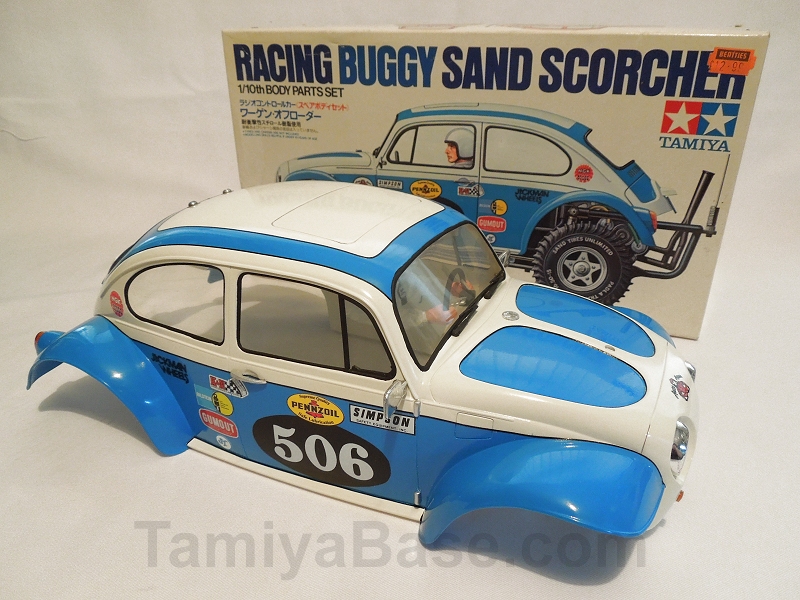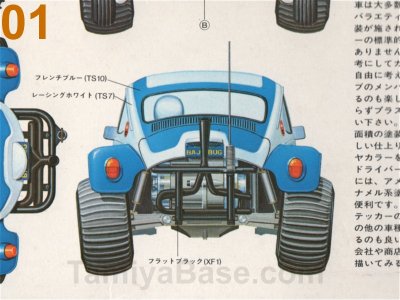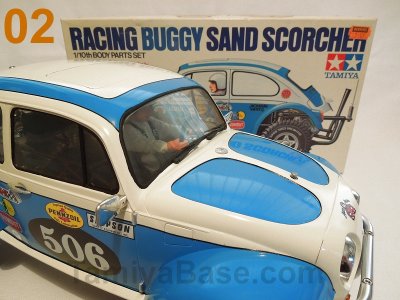Just what colour should the Sand Scorcher be? If you said "French Blue" (and white) then a lot of people would agree with you - any online source you care to look at is going to tell you the "correct" colours for the Sand Scorcher are TS-7 Racing White and TS-10 French Blue.
However, I don't think that's right - or at least, not always.
Note: I have to admit that the way colours are reproduced on screen may be undermining my argument here, perhaps to a fatal extent - all the blue colours here, despite being obviously different to the naked eye when the actual items are right in front of me, all look the same on my monitor.
Where French Blue is right:
Re-release (2010) models - those colours are specifically called out in the build manual. Although let's face, every man & his whippet has a French Blue and white Scorcher.
Where French Blue is sometimes right:
Later vintage examples - I don't have a specific date in mind, for discussion purposes let's say that mk.2 Scorchers (original "grey" bumper, stubs instead of screws for locating the springs in the front suspension towers, "normal" looking front arms, space for only a single 1150 bearing in each rear arm, plus a whole load of detail changes on the gearbox castings, and no doubt things I can't remember off the top of my head) probably should be painted French Blue, if you want it to be "box art".
I can't say anything other than that, because the vintage bodyset (which dates from later than the kit) box illustrations call for TS-7 and TS-10. However, the illustrations match spookily well to the brush paint X-14 "Sky Blue" - and not "French Blue" at all (images 01 & 02).
A further "however" is that I also have to go on my experience of the period. Although you'd have been able to buy a Scorcher kit from most British model shop worthy of the name at the end of the 1970s/very early 1980s, there is no way you'd have been able to get Tamiya aerosol paints of any description.
If you were very lucky you might have been able to get Tamiya X & XF brush paints, but more likely your "choice" would have been a rack of Humbrol Enamel tinlets, or to go to your local motor factors (or Halfords) & pick out a couple of colours that looked close.
Given the high relative cost of the kit, plus the radio gear, battery, charger, more batteries for the transmitter, you (or your parents) would probably have drawn the line at the metal bearings the model shop might have tried to push, let alone spending even more on paints.
This I suspect is why you see so many "loft find" Sand Scorchers brush painted in whatever little Johnny had left over from his Airfix kits, or whatever cellulose rattle cans dad had left over in the garage. Compared to any of the randomness that produced, any blue/white combination really should be considered "correct".
TS paints didn't appear in the English language edition of the Tamiya Catalogues until 1997, which I think backs up my point: the further you got from Japan, politically as well as geographically, the less likely it is that you can be prescriptive about what the "correct" colours should be.
Glossing over (boom! boom!) the non-availability of Tamiya TS paints in the UK for several years at the end of the noughties/beginning of the teenies due to "labelling issues", the insistence that there are correct colours to use and that anything else is wrong is a luxury (and a laziness, IMO) borne of easy access to items from all over the world, undreamt of in the past.
To summarise, if you were building a later Scorcher in Europe, you probably would have just used any mid blue you could get your hands on, maybe even a colour called French Blue. But it almost certainly wouldn't have been a Tamiya product.
Where French Blue is Definitely Wrong
Mk.1 Scorchers, which had the original black bumper, screws in front towers instead of stubs, much thinner front arms, gearbox casting differences, space for dual bearings in rear arms, etc - which for discussion purposes we'll say was available in 1979 and 1980 (?) shouldn't be French Blue IMO if you want it to be "correct".
In earlier Tamiya photos (there's a specific one used in a lot of Tamiya materials for several years, image 03 shows a scan of it from the 1983 RC Guide Book) showing a Mk.1 (or possibly even prototype, judging by the impossibly pale radio box without embossing) Scorcher with paintwork that looks very much like X-14 Sky Blue.
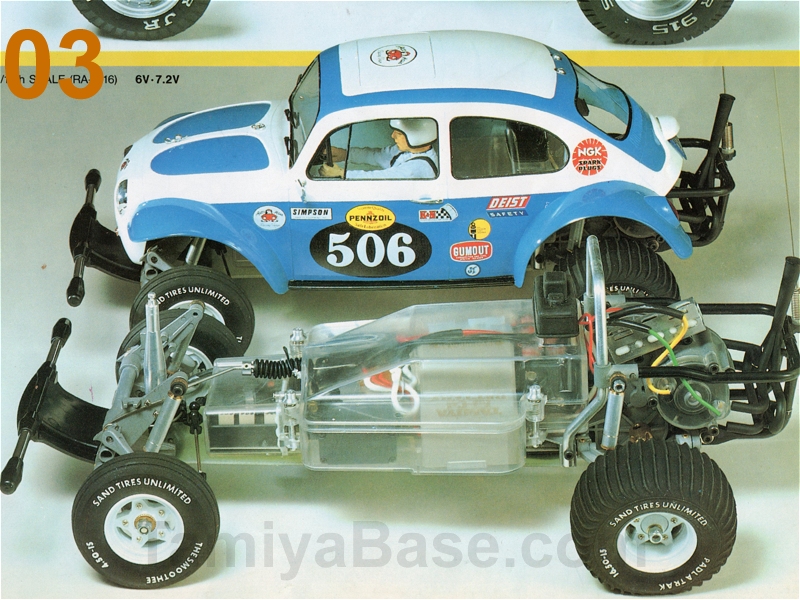
The colours aren't called out in vintage build manuals. The example in the vintage Scorcher isn't even blue and white - red and yellow are called out, and not even with Tamiya reference numbers.
The earliest appearance of TS paints in Tamiya literature (thanks Lars) is in the Japanese version of the 1981 RC Guide Book. From that I deduce that the very earliest adopters of the Sand Scorcher (which has an official release date of December 1979) just wouldn't have been able to buy the "correct" paint at all, so any blue white combination that looked like the box could be considered "box art". If you wanted to stick with Tamiya paints your choices would have been pretty much limited to X-4 Blue (which looks far too dark) or X-14 Sky Blue (which is a pretty good match - but if you go by the cap alone it can look worryingly lurid).
Thought Experiments
Try to look at the illustration on the box (image 04) with an objective eye - I'm not sure that even on average you could call that French Blue, the colours look to me to vary between Sky Blue and Royal Blue, via several shades of blue in the middle -and even if it does look French Blue, that doesn't mean it's correct - I'm thinking specifically of the Rough Rider and Sand Rover that look red on the box but "should" be orange, and the later Mitsubishi Pajero Metaltop Wide that looks black but "should" be blue.
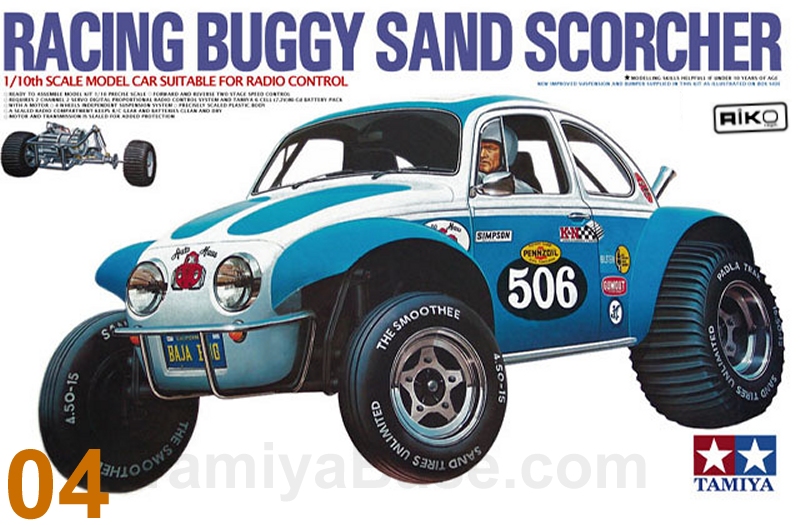
Think about it - if you didn't already "know" that colour was "supposed" to be "French Blue" and I showed you an appropriate colour chip & asked you if it was in fact "Wedgewood Blue", would you agree?
Repeat the same thought experiment but substitute "1970's British Rail locomotive blue" or "Oxford Blue" - same result? The results would vary by gender (most women have a better sense of colour differentiation than most men), whether I was wearing a white coat & spoke in RP (or wore a silly hat & reverted to a Norfolk accent), or whether I told you what was "correct" or guided you to your own conclusion - physiology and psychology would be at least as important as the actual colour.
Conclusion
To summarise (and at the risk of being branded a nerd by some Tamiya fans, and/or being burned at the stake by another group) this is what I think should be considered "correct":
| Mk.1 (1979-1980) | Mk.2 (1981-1984) | Re-release (2010 on) |
| X-14 Sky Blue and any white or off-white | Japan, & probably the USA: Tamiya French Blue & Racing white. UK (& probably the ROW): some sort of French Blue & white, just not Tamiya. |
Tamiya French Blue & Racing white. |
________________________
________________________
Written by TB member Jonny Retro



